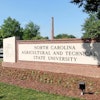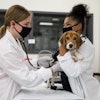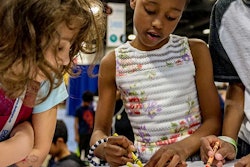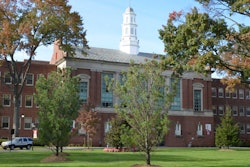The nation’s current economic problems show that it is more important than ever to increase the participation of minority-group members and women in technical fields if the country is to maintain the scientific leadership that has driven prosperity for decades, experts say.
Even in a near-stagnant economy, job opportunities abound for those careers focused on science, technology, engineering and mathematics, fields collectively known as STEM. Fewer Americans are training for these jobs, which increasingly are going to those who were born in other countries and educated here.
According to the U.S. Bureau of Labor Statistics, STEM fields are expected to add 2.7 million new jobs by 2018, an enormous prospect for those who are prepared and a huge missed opportunity for those who are not. The need to improve STEM education in the U.S. became a priority for government, business and academe following the release in 2005 of a congressionally mandated report, “Rising above the Gathering Storm.” The study by the National Academy of Sciences predicted an erosion of U.S. scientific and technical leadership and economic influence unless the country improved and expanded STEM education for its citizens.
In a follow-up report released in 2010, the academy and its companion National Academy of Engineering and Institute of Medicine said underrepresented minority people represent a largely untapped pool of American talent that could help fill the coming wave of STEM jobs. Of college-educated Americans, people of racial and ethnic minorities—including African-, Hispanic and Native Americans—represented only 9 percent of those in science and engineering occupations in 2006, a figure that would need to triple to match the share of minorities in the U.S. population, the report said. (Asians are considered well represented in the sciences, based on their proportion of the general population.)
After years of probing for the right solutions, experts say efforts to increase the representation of minorities in scientific and technical fields are starting to zero in on programs that could be tried on a larger scale.
Opportunity for Disabled
Students with disabilities are one minority group targeted for inclusion in STEM programs. The National Science Foundation has been sponsoring programs since 1994 to include people with disabilities in STEM-associated professional careers. According to 2008 agency figures, those with disabilities represented slightly more than 10 percent of undergraduate students majoring in engineering, mathematics, and computer and physical science. In graduate studies, they made up about 6 percent of students in those fields and 9 percent studying social and behavioral sciences.
The Minority-Disability (MIND) Alliance in STEM project, sponsored by the foundation, is one designed to find ways to channel students with disabilities from racial and ethnic minority backgrounds into scientific and technical careers. Two institutions of higher education, Hunter College of the City University of New York and Southern University in Baton Rouge, La., have for three years held week-long summer institutes for high school students to expose them to the sciences and career possibilities.
Dr. Elizabeth Cardoso, the project’s principal investigator, said students in the New Jersey-New York area and in Louisiana go through a program that includes tracking their interests during subsequent school years and providing technical workshops at the participating high schools for students, teachers, counselors and parents.
Another part of the program is recruiting college students from the area and assisting them in applying for science-related internships. So far, the program has involved 214 high school and college students in the New Jersey-New York area and 144 in Louisiana.
“We have students with all types of disabilities—learning, physical, psychological—and try to interest them in the possibilities of careers they may not have considered possible before,” Cardoso said. “We want them to say ‘Yes, I can do this’ or ‘I can try this.’”
Many of the participating high school students continue interest in the program after the summer sessions, and at least 15 of the college students have been placed into STEM internships, Cardoso said. If the project, funded for five years, proves successful, it could be a model others could try elsewhere, she added.
Early Interventions Needed
Boosting the proportion of STEM professionals among underrepresented groups—including ethnic minorities, the disabled and women—requires a national effort that begins in grades K through 12 and continues into the college years, experts say. This includes showing students that science and math are interesting and practical and can lead to fulfilling careers later. When teachers do not approach science in appealing ways or if students perceive it as “nerdy” or “un-cool,” interest declines over time.
“Our greatest losses of students interested in science begin early on, in the early grades and high school, and continues on into college,” said Dr. Shirley M. Malcom, head of education and human resources programs at the American Association for the Advancement of Science.
Too often, she said, introductory science courses in college are more about weeding out the weakest students than encouraging participation. There should be more wide-ranging efforts to provide more students with the background to go into STEM fields, she said, arguing that there is no single approach to act as a silver bullet for solving the problem.
“This is a systems problem that can’t be solved by one thing,” Malcom said. “You have to manage a number of moving parts.”
Those include early education, teacher preparation, curricula, family social and economic situations, social pressures on students, role models and numerous other factors, she said.
Community Colleges Offer Hope
Minorities and women continue to be underrepresented in the engineering profession in spite of modest gains in recent years, said Dr. Irving Pressley McPhail, chief executive officer of the National Action Council for Minorities in Engineering. Key to increasing the number of minorities in engineering may be putting more emphasis on community colleges, he said.
Less than 13 percent of engineering graduates come from underrepresented minority groups, McPhail said, hardly enough to change significantly the complexion of the nation’s engineering workforce, which is now 4.5 percent African-American, 5.5 percent Hispanic and 12.7 percent Asian. Women account for just 12.7 percent of engineering professionals. Over the past 30 years, his organization has provided $124 million to support scholarships for 24,000 minority engineering students, but he says more needs to be done.
“There are some very interesting initiatives going on across the country, and I am excited, not pessimistic, about the future of diversity in engineering,” he said. McPhail said a majority of minority students seek higher education through community colleges, which have a major role in preparing many students for transfer to four-year baccalaureate institutions. Half of these community colleges have good technology programs to prepare students for transfers, but these efforts can be improved by establishing partnerships with engineering schools to make sure those earning associate degrees meet the next institution’s requirements.
However, it is difficult to get into these transfer programs without basic coursework in science, technology and, particularly, mathematics in high school, which remains a challenge, he said.
McPhail said his organization is working with Springfield Technical Community College in Massachusetts to develop a model curriculum that uses engineering principles to show practical applications of mathematics to make it more understandable and relevant. The partnership is looking for four other community colleges elsewhere in the country to help test the new approach.
“We think this will get around the conundrum of the basic math needed for STEM transfers,” he said. “This program could be a model for community colleges throughout the country.”
Many underprivileged minorities do not see engineering as a career choice, he said, suggesting that professional societies, teachers and guidance counselors become more active in promoting its benefits.
“Not only are there jobs but they pay good salaries,” McPhail said. “The starting salary for biomedical science engineers is $77,000, and it’s even higher for petroleum engineers. STEM professions can be very lucrative.”
— Warren E. Leary, a journalist who has reported on science, technology and medicine for more than 40 years, is a retired science correspondent for The New York Times.


















